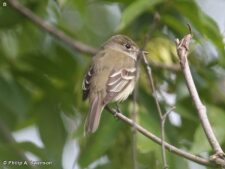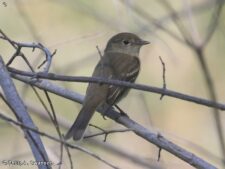
5.75 inches long. The Willow Flycatcher is a small flycatcher but relatively large when compared to other members of the genus Empidomax. It has an indistinct white eye ring and a wide, a dull yellow-orange lower bill. The upperparts are brownish-olive. The White throat contrasts with a diffuse, dull olive to brownish breast band. In spring the belly may have a yellowish tinge. It has white wing bars. The eye-ring, wing-bars, breast-band are most conspicuous in fresh, spring birds The breast-band is less distinct and belly less yellowish with wear.First fall birds have buff wing bars rather than white wing bars. This is one of five small “Empids” (Empidonax Flycatchers) that may show up in the Forest. It is best identified by its call. Differences in plumage due to molt, wear and age make the plumage quite variable. This species is extremely similar to the Alder Flycatcher (Empidonax alnorum). Acadian (Empidonax virescens) and Yellow-bellied Flycatchers (Empidonax flaviventris) tend to be greener above and yellower below than the Willow Flycatcher. The Least Flycatcher (Empidonax minimus) is grayer above, smaller, shorter-tailed and has a more distinct eye ring.
The Willow Flycatcher is an uncommon summer resident that may breed in the Forest. It appears in mid to late May and leaves by mid to late September.
The Willow Flycatcher was formerly considered con-specific with the Alder Flycatcher. The two together were referred to as Traill’s Flycatcher until 1973, when they were recognized as separate species. Willow Flycatchers are late spring migrants and have a short, 70- to 90-day breeding season. The Willow Flycatcher prefers dense stands of willow shrubs. It nearly always has only a single brood, laying a clutch of 3 or 4 eggs in late May–late June. The incubation period is 13–14 days, and young fledge about 13–15 days after hatching, usually in mid-July. The Willow Flycatcher is primarily an aerial forager, capturing most of its insect diet on the wing, but it may hover-glean from leaf surfaces or occasionally take insects from the ground. Willow and Alder Flycatchers are basically indistinguishable except by voice. The call of Alder usually an emphatic “pip” or “pit”, whereas Willow a liquid “whit”. The Alder Flycatcher has a harsh, burry song with a strongly accented second syllable, traditionally described as a 3-syllable “fee-BEE-o”, but which may be heard as a 2-syllable “free-BEER”, with the third syllable faint, indistinct. The Willow Flycatcher’s song is strongly accented on first syllable and traditionally described as “FITZ-bew”.
Disclaimer: The content of NatureSearch is provided by dedicated volunteer Naturalists of Fontenelle Forest who strive to provide the most accurate information available. Contributors of the images retain their copyrights. The point of contact for this page is: Phil Swanson.


